One Minute With…
Simon Collison
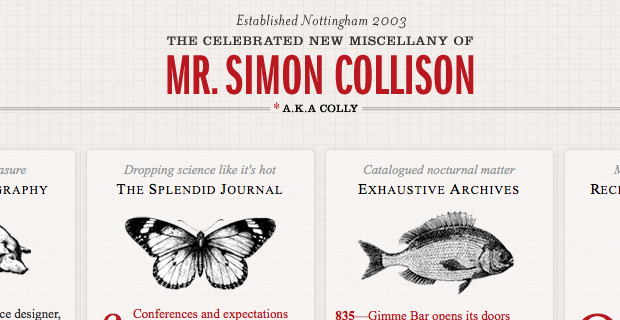
Hi Simon, thanks for taking time to chat with One Minute With. Tell us a little bit about yourself and your work.
I’m a freelance designer and much more, and I’ve been at it for twelve years. I’m based in Nottingham, but work all over the world. I’m a former artist, I founded a successful agency then left, I write and present about design, and I also organise the New Adventures events.
What else? Well, I am not “full-geek”. I’m obsessed with music. I love traveling. I own a stupid cat. Apparently I’m bad at relationships. I’m happy regardless. That’ll do.
Walk us through a typical day in the life of Simon Collison.
I get up later than I’d aimed for, wherever I am. My working life falls two different ways. I’m either at home for a few weeks and therefore in my home office, or I’m away working collaboratively in different places, or bouncing between conferences.
I’m a tea man, but need a frothy coffee and a roll-up before I do anything. I hit the computer straight away and I’ll tap a load of ideas into Evernote that I had overnight. I’ll mark fifty emails as junk, flag twenty or so, respond to three. Next, I’ll cycle through my tweets/Flickr/Instagram/GimmeBar feeds and read the BBC and Guardian sites for a bit. I used to trawl RSS but don’t do that at all any more. Does anyone?
Mid-morning, I’ll start doing some proper work. iTunes is on all day and I dance around to it until around 6pm when I try to switch off, watch the news, do normal human things, or do more work. If I’m away, I’ll hit the bars with friends and not talk about work.
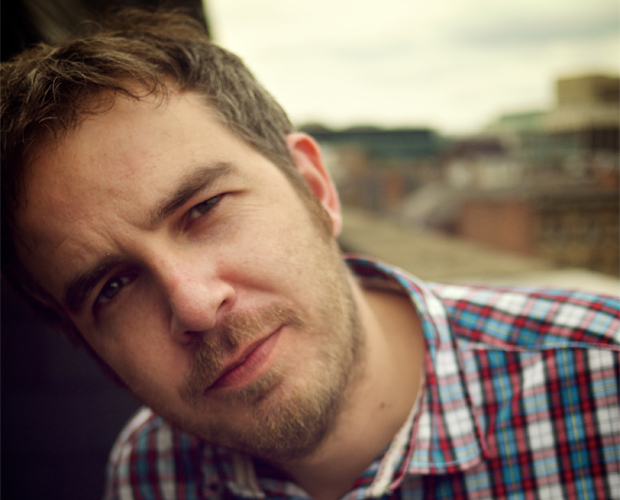
How did you get into design?
I was always interested in art, design and popular culture. Long story short; I went to art school, became an artist, and eventually set up an arts organisation. I bought a computer in 1999 to make flyers and posters, discovered HTML, and made a big website for the arts org that became really popular. A local agency saw it, thought I’d make a good web designer, and that was that. Gave up the art, became a full-time designer.
How do you approach a new project? What’s your design process like?
So, I have my own rules and methods, but every job is different. Back when I ran an agency, the process was very different, and we imposed all sorts of strict criteria and methodologies on each project. As a freelancer, I keep it much looser, so I don’t always manage projects with a set pattern. I’m lucky that I can choose to work on projects that suit me, where I won’t be restricted or lost in documentation. I’ve learned to maximise the creative time now.
Obviously I learn as much as I can about the project (and if relevant, the client) and the intended audience. I try to have a lot of discussion, gather qualitative and quantitative data, and I make a lot of notes and sketches. I soak up the content and stuff I need to work with, and I will sit with it all for ages – not working, just thinking about it. When ready, I then get into some freestyle design without grids, guidelines or frameworks, where I just explore ideas and get everything down into Photoshop iterations.
Then will come a phase where I begin to properly define grids, layout, icons, colours, language, tone of voice, resulting in a set of loose guidelines I can take into a more robust and meticulous Photoshop stage. If I’m also building the site, I start designing in the browser as early as poss using a Git repo, often making a greybox navigable site to understand the behaviours and relationships, taking that into a final design in the browser, backed up with PSDs perhaps.
But like I say, every job is different, and as I collaborate a lot, I might be focused on one task, yet giving input across everyone’s work.
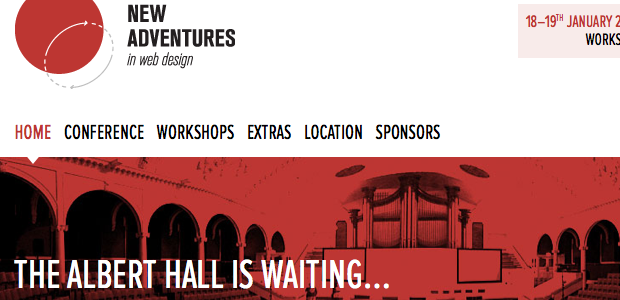
In addition to your design work itself, you’ve written several books about design and development, and spoken at numerous conferences. If, in some crazy hypothetical universe, you could only do one of these things (Design, Books, Conferences), which would it be, and why?
The writing and presenting is a byproduct of being a designer, and unless I decided to write bad poetry or fiction as I did in my teens, then there’d be no writing or presenting without being a designer. Design is my ultimate motivation, and whilst I think it’s important to share and discuss with others, ultimately I’d cling tooth and nail to my job as a designer. Without that, it’d just be hot air.
You’re very much a conference man, having spoken at many, and even organised your own. What it is about conferences that you like so much, and why did you decide to organise your own?
I find value in every event I attend. If the exact topic isn’t applicable, I work hard as an attendee to find relevance and parallels for me. There’ll always be something I can take away, and that might not immediately influence my work, but often I find that value a week, a month, a year later. It all goes in.
Conferences also allow us to get away from our working environments and meet others, discuss issues that concern us, form new partnerships, sow the seeds of collaboration, and be inspired from all angles. I can think of nothing worse than being a designer who never leaves his or her desk. I used to beg and borrow to attend conferences for a thousand reasons. Being able to speak and be a part of the dialogue directly is a huge privilege.
My own event was a response to all of this and more. There are lots of reasons, but two in particular. 1: My home town and its surrounding cities have a wealth of design talent that has been underserved by such events, and I thought it was high time we had something of value in the heart of England. 2: I desperately care about issues that shape our roles as web designers, and the dialogue needs specific platforms to thrive. New Adventures was motivated by a desire to get smart people (speakers and audience) together to push things forward, and maybe influence some of the issue that resonate through the rest of the year.
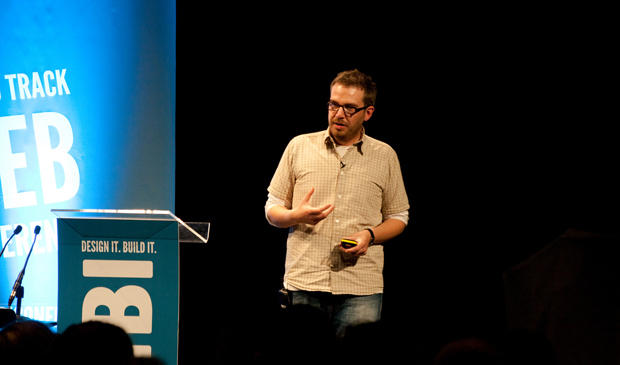
Where do you see yourself in 5 or 10 years? Are you still hoping to be designing, writing and speaking, or do you want to have moved onto to something else?
I try not to answer questions like this these days. The reason is simple: I try not to set goals. It was important to have certain ambitions or get-out plans when I was a bit younger, but since I went freelance I’ve removed the pressure. I’ll see where projects and opportunities take me, but in all honesty, I’m more interested in just “doing” than wondering where it’ll take me. One things for sure: I’ll be living in Brooklyn by then, whatever I’m doing.
What design tools could you not live without?
I’m trying to get away from the idea of apps defining what I do and how I think, so I’d say I cannot do without my bag, which I think of as a mobile office. I’ve meticulously honed what I need to carry and everything has a pocket. Obviously it’s got my MacBookAir and iPhone in it, but alongside those I have a cheap Muji notebook I can scribble in, plus a pen, pencil, and a Sharpie. Aside from chargers, headphones, and travel stuff, that’s all I need, and all I want.
If you want a list of the apps I use then it’s fair to say I have Photoshop, Textmate, Transmit, MAMP, Github, Evernote, IA Writer, iTunes, iCal, Mail app, and Safari open most of the time.
Regarding browsers, I just love and trust Safari. Firefox is made of mud and twigs, and I can’t stand Google Chrome. Where’s the bloody feedback when you load things. I hate the lack of a blue bar or visual progress. Just can’t get past that.
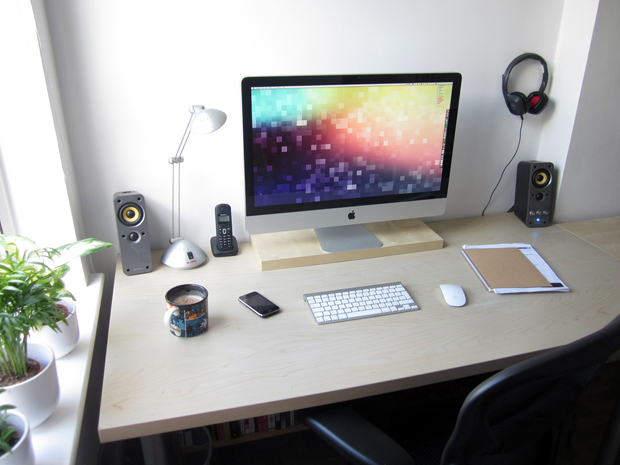
And finally, what tips would you give to anybody who is looking to get started in design?
Be prepared to work hard. If it will overlap with another job you don’t like, be prepared to do several hours per night reading, learning, experimenting. Identify your strengths and weaknesses, discover your values, and try to approach your work like a craftsmen. Do your work and do it well.
On a practical level, find problems and design responses. Not answers, not solutions, just responses. There’s rarely a single right way, so just explore problems and see what happens. Try to be loose and unshackled to start with, then home in on details and work tightly as you near completion. Learn to throw things out, simplify, be economical, present only what is necessary. After that, adding delight and personality in future projects comes naturally.
Desire to learn, and don’t see it as too much information to cope with, too many opinions, too many things changing all the time. Embrace the ebb and flow, the shifting landscape; that’s what makes the web so unique, so special. Understand the medium, appreciate where the web can borrow from other disciplines, and where it stands apart and defines its own rules.
Don’t feel bound by your tools. try to think about design outside of apps. Tools are enablers, but what we do isn’t about those tools or languages. Also, don’t be a slave to web showcases and galleries. Find inspiration from anywhere and everywhere, not just from other websites.
Above all, care. I mean, really care about what you do. Being a designer isn’t a job, it’s a motivation, a need to make things better. If that doesn’t sound right for you, then don’t be a designer.
1 Comment
Martin Davies
Great interview and really inspiring!